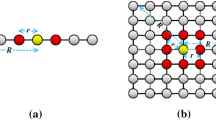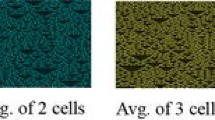Abstract
Cellular automata (CAs) have been successfully used to investigate complex phenomena across a broad range of research fields. Standard CAs can be extended by applying a novel algorithm known as the recursive estimation of neighbors. This process allows the construction of non-uniform CAs that are composed of cells with different perception areas parameterized by an extra radius. This paper proposes a non-uniform CA called Fractal CA (F-CA), which is composed of cells with self-similar fractal arrangement. By focusing on the extension of 1D elementary CAs, certain characteristics of standard CAs are carried over into F-CAs, including time reversibility of the linear rules. F-CAs based on 2D outer-totalistic CAs are also mentioned briefly.










Similar content being viewed by others
Explore related subjects
Discover the latest articles, news and stories from top researchers in related subjects.Notes
Other options are beyond the scope of this paper.
References
von Neumann J (1966) The theory of self-reproducing automata. In: Burks AW (ed) Essays on cellular automata. University of Illinois Press, Illinois
Reynolds CW (1987) Flocks, herds and schools: a distributed behavioral model. ACM Siggraph Comput Gr 21(4):25–34
Kayama Y (2016) Extension of cellular automata by introducing an algorithm of recursive estimation of neighbors. In: Proceedings of the 21st international symposium on artificial life and robotics, pp 73–77
Kayama Y (2016) Expansion of perception area in cellular automata using recursive algorithm. In: Proceeding of the fifteenth international conference on the simulation and synthesis of living systems, pp 92–99
Wolfram S (1983) Statistical mechanics of cellular automata. Rev Mod Phys 55:601–644
Wolfram S (2002) A new kind of science. Wolfram Media Inc, Champaign
Li W, Packard N (1990) The structure of the elementary cellular automata rule space. Complex Syst 4:281–297
Chaudhuri PP (1997) Additive cellular automata: theory and applications, vol 1. Wiley, Oxford
Encinas LH, del Rey AM (2007) Inverse rules of eca with rule number 150. Appl Math Comput 189(2):1782–1786
Mandelbrot BB, Pignoni R (1983) The fractal geometry of nature, vol 173. WH freeman, New York
Gardner M (1970) Mathematical games. Sci Am 223:102–123
Berlekamp ER, Conway JH, Guy RK (1982) Winning ways for your mathematical plays. Academic Press, New York
Adamatzky A (ed) (2010) Game of life cellular automata. Springer, London
Eppstein D (2010) Growth and decay in life-like cellular automata. In: Adamatzky A (ed) Game of life cellular automata. Springer, Berlin, pp 71–98
Wang X, Luan D (2013) A novel image encryption algorithm using chaos and reversible cellular automata. Commun Nonlinear Sci Numer Simul 18(11):3075–3085
Acknowledgements
The author wishes to thank all the anonymous reviewers for valuable comments and suggestions.
Author information
Authors and Affiliations
Corresponding author
Additional information
This work was presented in part at the 23rd International Symposium on Artificial Life and Robotics, Beppu, Oita, January 18–20, 2018.
About this article
Cite this article
Kayama, Y. Cellular automata in fractal arrangement. Artif Life Robotics 23, 395–401 (2018). https://doi.org/10.1007/s10015-018-0448-8
Received:
Accepted:
Published:
Issue Date:
DOI: https://doi.org/10.1007/s10015-018-0448-8




